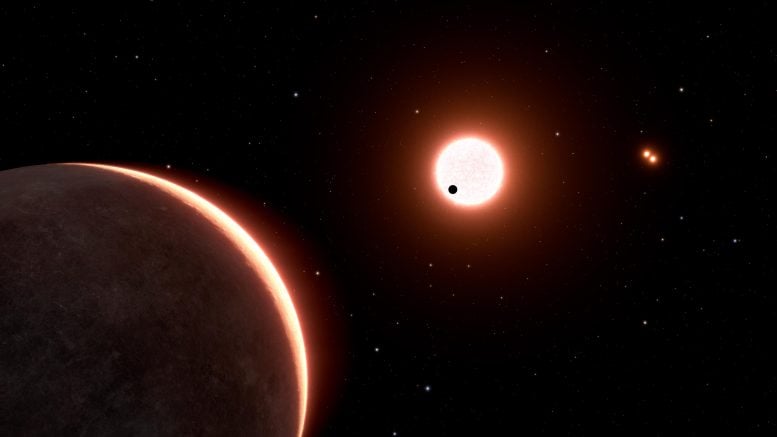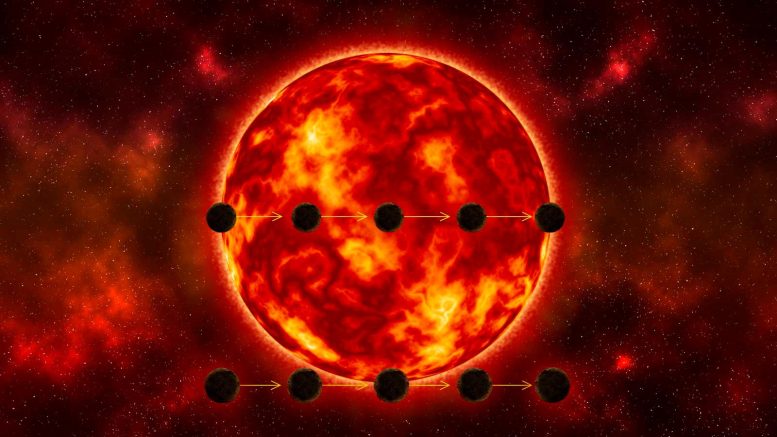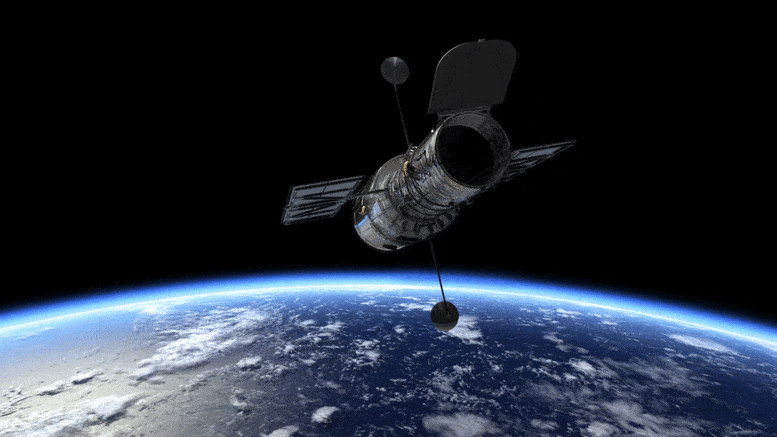Unearthing the Secrets of a Nearby Earth-Sized World
NASA’s Hubble Telescope accurately measured LTT 1445Ac, an Earth-sized exoplanet in a nearby triple star system. Initially discovered by TESS, this rocky planet is similar in size to Earth but much hotter. The research enhances our knowledge of exoplanets and their atmospheres. Credit: ESA/Hubble (M. Kornmesser & L. L. Christensen)
Hubble Telescope confirms the size of Earth-like exoplanet LTT 1445Ac, offering new insights into its composition and the potential for further atmospheric study.
Lots of planets around neighboring stars are not seen directly. Instead, they are found when they temporarily pass in front of their parent star, an event called a transit. During the transit they block out a little bit of light from the star, essentially casting a shadow to Earth-watchers.
Astronomers learn a lot from these transient events. They can measure the planet’s orbital period, study its atmosphere, and estimate its size. What’s tricky is that the planet may only graze the edge of the star during a transit, giving an inaccurate measurement of its diameter.
One such nearby exoplanet, LTT 1445Ac, only 22 light-years away, was first identified by NASA’s Transiting Exoplanet Survey Satellite (TESS). But TESS does not have the required optical resolution to pin down the planet’s exact diameter by refining its trajectory across the face of a star.
Along came Hubble with its sharp vision to precisely measure the planet’s diameter to be only 1.07 times Earth’s diameter. This makes it a cousin of Earth in terms of size. But that’s where all similarity ends. LTT 1445Ac is too close to its red dwarf sun for habitability. Surface temperatures are roughly 500 degrees Fahrenheit – the temperatures inside a pizza oven.

This is an artist’s concept of the nearby exoplanet LTT 1445Ac, which is the size of Earth. The planet orbits a red dwarf star. The star is in a triple system, with two closely orbiting red dwarfs seen at upper right. The black dot in front of the bright light-red sphere at image center is planet LTT 1445Ac transiting the face of the star. The planet has a surface temperature of roughly 500 degrees Fahrenheit. In the foreground at lower left is another planet in the system, LTT 1445Ab. The view is from 22 light-years away, looking back toward our Sun, which is the bright dot at lower right. Some of the background stars are part of the constellation Boötes. Credit: NASA, ESA, Leah Hustak (STScI)
Hubble Space Telescope Measures the Size of the Nearest Transiting Earth-Sized Planet
NASA’s Hubble Space Telescope has measured the size of the nearest Earth-sized exoplanet that passes across the face of a neighboring star. This alignment, called a transit, opens the door to follow-on studies to see what kind of atmosphere, if any, the rocky world might have.
The diminutive planet, LTT 1445Ac, was first discovered by NASA’s Transiting Exoplanet Survey Satellite (TESS) in 2022. However, the geometry of the planet’s orbital plane relative to its star as seen from Earth was uncertain because TESS does not have the required optical resolution. This means the detection could have been a so-called grazing transit, where a planet only skims across a small portion of the parent star’s disk. This would yield an inaccurate lower limit of the planet’s diameter.
“There was a chance that this system has an unlucky geometry and if that’s the case, we wouldn’t measure the right size. But with Hubble’s capabilities we nailed its diameter,” said Emily Pass of the Center for Astrophysics | Harvard & Smithsonian in Cambridge, Massachusetts.
Hubble observations show that the planet makes a normal transit fully across the star’s disk, yielding a true size of only 1.07 times Earth’s diameter. This means the planet is a rocky world, like Earth, with approximately the same surface gravity. But at a surface temperature of roughly 500 degrees Fahrenheit, it is too hot for life as we know it.

This diagram compares two scenarios for how an Earth-sized exoplanet is passing in front of its host star. The bottom path shows the planet just grazing the star. Studying the light from such a transit could lead to an inaccurate estimate of the planet’s size, making it seem smaller than it really is. The top path shows the optimum geometry, where the planet transits the full disk of the star. Hubble Space Telescope’s accuracy can distinguish between these two scenarios, yielding a precise measurement of the planet’s diameter. Credit: NASA, ESA, Elizabeth Wheatley (STScI)
The planet orbits the star LTT 1445A, which is part of a triple system of three red dwarf stars that is 22 light-years away in the constellation Eridanus. The star has two other reported planets that are larger than LTT 1445Ac. A tight pair of two other dwarf stars, LTT 1445B and C, lies about 3 billion miles away from LTT 1445A, also resolved by Hubble. The alignment of the three stars and the edge-on orbit of the BC pair suggests that everything in the system is co-planar, including the known planets.
“Transiting planets are exciting since we can characterize their atmospheres with spectroscopy, not only with Hubble but also with the James Webb Space Telescope. Our measurement is important because it tells us that this is likely a very nearby terrestrial planet. We are looking forward to follow-on observations that will allow us to better understand the diversity of planets around other stars,” said Pass.
This research has been published in The Astronomical Journal.
Reference: “HST/WFC3 Light Curve Supports a Terrestrial Composition for the Closest Exoplanet to Transit an M Dwarf” by Emily K. Pass, Jennifer G. Winters, David Charbonneau, Aurelia Balkanski, Nikole Lewis, Maura Lally, Jacob L. Bean, Ryan Cloutier and Jason D. Eastman, 25 September 2023, The Astronomical Journal.
DOI: 10.3847/1538-3881/acf561
The Hubble Space Telescope is a project of international cooperation between NASA and ESA. NASA’s Goddard Space Flight Center in Greenbelt, Maryland, manages the telescope. The Space Telescope Science Institute (STScI) in Baltimore, Maryland, conducts Hubble science operations. STScI is operated for NASA by the Association of Universities for Research in Astronomy, in Washington, D.C.

NASA’s Hubble Telescope accurately measured LTT 1445Ac, an Earth-sized exoplanet in a nearby triple star system. Initially discovered by TESS, this rocky planet is similar in size to Earth but much hotter. The research enhances our knowledge of exoplanets and their atmospheres. Credit: ESA/Hubble (M. Kornmesser & L. L. Christensen)
Hubble Telescope confirms the size of Earth-like exoplanet LTT 1445Ac, offering new insights into its composition and the potential for further atmospheric study.
Lots of planets around neighboring stars are not seen directly. Instead, they are found when they temporarily pass in front of their parent star, an event called a transit. During the transit they block out a little bit of light from the star, essentially casting a shadow to Earth-watchers.
Astronomers learn a lot from these transient events. They can measure the planet’s orbital period, study its atmosphere, and estimate its size. What’s tricky is that the planet may only graze the edge of the star during a transit, giving an inaccurate measurement of its diameter.
One such nearby exoplanet, LTT 1445Ac, only 22 light-years away, was first identified by NASA’s Transiting Exoplanet Survey Satellite (TESS). But TESS does not have the required optical resolution to pin down the planet’s exact diameter by refining its trajectory across the face of a star.
Along came Hubble with its sharp vision to precisely measure the planet’s diameter to be only 1.07 times Earth’s diameter. This makes it a cousin of Earth in terms of size. But that’s where all similarity ends. LTT 1445Ac is too close to its red dwarf sun for habitability. Surface temperatures are roughly 500 degrees Fahrenheit – the temperatures inside a pizza oven.

This is an artist’s concept of the nearby exoplanet LTT 1445Ac, which is the size of Earth. The planet orbits a red dwarf star. The star is in a triple system, with two closely orbiting red dwarfs seen at upper right. The black dot in front of the bright light-red sphere at image center is planet LTT 1445Ac transiting the face of the star. The planet has a surface temperature of roughly 500 degrees Fahrenheit. In the foreground at lower left is another planet in the system, LTT 1445Ab. The view is from 22 light-years away, looking back toward our Sun, which is the bright dot at lower right. Some of the background stars are part of the constellation Boötes. Credit: NASA, ESA, Leah Hustak (STScI)
Hubble Space Telescope Measures the Size of the Nearest Transiting Earth-Sized Planet
NASA’s Hubble Space Telescope has measured the size of the nearest Earth-sized exoplanet that passes across the face of a neighboring star. This alignment, called a transit, opens the door to follow-on studies to see what kind of atmosphere, if any, the rocky world might have.
The diminutive planet, LTT 1445Ac, was first discovered by NASA’s Transiting Exoplanet Survey Satellite (TESS) in 2022. However, the geometry of the planet’s orbital plane relative to its star as seen from Earth was uncertain because TESS does not have the required optical resolution. This means the detection could have been a so-called grazing transit, where a planet only skims across a small portion of the parent star’s disk. This would yield an inaccurate lower limit of the planet’s diameter.
“There was a chance that this system has an unlucky geometry and if that’s the case, we wouldn’t measure the right size. But with Hubble’s capabilities we nailed its diameter,” said Emily Pass of the Center for Astrophysics | Harvard & Smithsonian in Cambridge, Massachusetts.
Hubble observations show that the planet makes a normal transit fully across the star’s disk, yielding a true size of only 1.07 times Earth’s diameter. This means the planet is a rocky world, like Earth, with approximately the same surface gravity. But at a surface temperature of roughly 500 degrees Fahrenheit, it is too hot for life as we know it.

This diagram compares two scenarios for how an Earth-sized exoplanet is passing in front of its host star. The bottom path shows the planet just grazing the star. Studying the light from such a transit could lead to an inaccurate estimate of the planet’s size, making it seem smaller than it really is. The top path shows the optimum geometry, where the planet transits the full disk of the star. Hubble Space Telescope’s accuracy can distinguish between these two scenarios, yielding a precise measurement of the planet’s diameter. Credit: NASA, ESA, Elizabeth Wheatley (STScI)
The planet orbits the star LTT 1445A, which is part of a triple system of three red dwarf stars that is 22 light-years away in the constellation Eridanus. The star has two other reported planets that are larger than LTT 1445Ac. A tight pair of two other dwarf stars, LTT 1445B and C, lies about 3 billion miles away from LTT 1445A, also resolved by Hubble. The alignment of the three stars and the edge-on orbit of the BC pair suggests that everything in the system is co-planar, including the known planets.
“Transiting planets are exciting since we can characterize their atmospheres with spectroscopy, not only with Hubble but also with the James Webb Space Telescope. Our measurement is important because it tells us that this is likely a very nearby terrestrial planet. We are looking forward to follow-on observations that will allow us to better understand the diversity of planets around other stars,” said Pass.
This research has been published in The Astronomical Journal.
Reference: “HST/WFC3 Light Curve Supports a Terrestrial Composition for the Closest Exoplanet to Transit an M Dwarf” by Emily K. Pass, Jennifer G. Winters, David Charbonneau, Aurelia Balkanski, Nikole Lewis, Maura Lally, Jacob L. Bean, Ryan Cloutier and Jason D. Eastman, 25 September 2023, The Astronomical Journal.
DOI: 10.3847/1538-3881/acf561
The Hubble Space Telescope is a project of international cooperation between NASA and ESA. NASA’s Goddard Space Flight Center in Greenbelt, Maryland, manages the telescope. The Space Telescope Science Institute (STScI) in Baltimore, Maryland, conducts Hubble science operations. STScI is operated for NASA by the Association of Universities for Research in Astronomy, in Washington, D.C.
